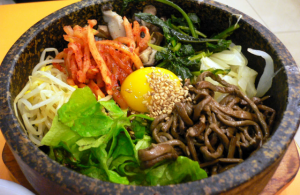This dish evokes my all time favorite childhood memory of my mother in America. She used to take me out to the fields and forage fiddlehead ferns to make this Korean dish of simmered braised fiddleheads. If you have ever eaten bibimbap in a Korean restaurant, then you’ve tasted gosari. They are the brown meaty twigs pictured in this bowl. The preparation gives it a meaty flavor and texture the way mushrooms get meaty. It was so delicious I would get really excited as a child when it was that time of year to pick gosari, despite the red ants that would bite me. My mother would fill several hefty garbage bags with it, then dry it on blankets in the sun until they were deep reddish brown. Then she would simmer it for hours in a braising liquid that gave it a deep, delicious meaty teriyaki type flavor. She did not let me eat them raw, saying they were no good that way. We didn’t make bibimbap with it, we just ate heaps of it with rice.
Recipe
First gather fiddleheads and dry them on a sheet or blanket in the sun until they turn a deep brown color and are barely flexible. This is an important step as dried fiddleheads taste differently from fresh the same way raisins no longer taste like grapes.
Ingredients:
1 pound dried fiddleheads
1 tablespoon sesame oil
3 tablespoons soy sauce
1 tablespoon sugar or sweetener of your choice
3 cloves garlic, crushed
water enough to barely submerge
Take the pound of dried fiddleheads and reconstitute them in fresh water overnight. In the morning rinse them in several changes of water and drain.
In a soup pan heat sesame oil over medium high heat. Saute fiddleheads, add garlic, add the soy sauce, sweetener and water then simmer with lid on over low heat for 1 hour or until all liquid is evaporated, stirring occasionally.
Sad part of this story is that I don’t ever see fields of fern bracken anymore. The few ostrich fern in my yard make enough for one dish, that’s it. 🙁
There is a lot of literature on the web implicating fiddleheads as carcinogenic. All I can say is that I’ve eaten tons of this stuff, literally, my whole life and I don’t have cancer of any form and neither did my mother and she ate it all of her life. I think it is very healthy to eat wild vegetables because they are survivors and pick the best places to grow, versus cultivated plants that don’t choose where they get to grow. Perhaps we should eat them the way my mother prepared them. They were my favorite food. I get them prepared in the Korean market and they are just not the same, sigh.

Bridget Paule
May 30, 2011
A very timely article for me! As part of the Alaska Food Challenge, a group of folks who, for one year starting this solstice, aim to eat only (or mainly) food produced locally here in Alaska , I’m starting to lay in stores of spring greens, including fiddleheads – pickled, frozen and now dried. In the woods last night a Korean woman came up to say hello and we compared what was in our foraging bags. She introduced me to the idea of drying the fiddleheads and your post here was the most useful webpage I’ve found so far on how to dry and then how to use them. Thanks for the recipe and best wishes on your sustainability plans.
admin
May 31, 2011
Hi Bridget,
That is so great! I’m so glad that sharing this warm memory of old foodways that my mother taught me was so helpful to you. Good luck to you with the Alaska Food Challenge!
J
September 8, 2011
Gosari is one of my favorite vegetables and an ingredient found in several popular Korean dishes. You can normally find gosari at Asian stores labeled as dried bracken and in a few cases boiled and packaged gosari in the refrigerated aisle. In addition to the recipe above, another popular use of gosari is a spicy beef soup called Yook Gae Jang. The dish is easy to prepare but takes a while to reconstitute the gosari/bracken and then prepare and cook the beef. Just thinking writing about it makes me want to make some.
Sustainable Sachi
September 8, 2011
Gosari is one of my favorite vegetables too! I also love burdock, which I’ve learned how to identify and have discovered grows wild and abundantly as a weed. Yook Gae Jang is one of my favorite dishes. It is so soul satisfying and really fulfills any craving I may have for spicy food.
Sustainable Sachi
September 8, 2011
Please share your Yook Gae Jang recipe.